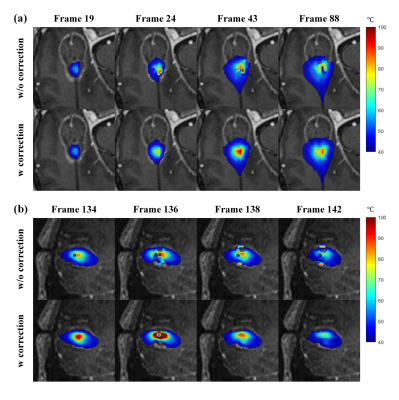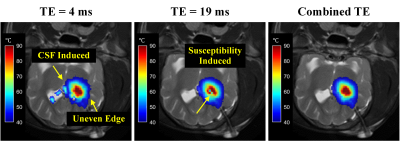Ziyi Pan1, Meng Han2, Yawei Kuang2, Hao Sun2, Kai Zhang3, Yuan Lian1, Yishi Wang4, Wenbo Liu2, Guangzhi Wang5, and Hua Guo1
1Center for Biomedical Imaging Research, Department of Biomedical Engineering, School of Medicine, Tsinghua University, Beijing, China, 2Sinovation Medical, Beijing, China, 3Beijing Tiantan Hospital, Capital Medical University, Beijing, China, 4Philips Healthcare, Beijing, China, 5Department of Biomedical Engineering, School of Medicine, Tsinghua University, Beijing, China
1Center for Biomedical Imaging Research, Department of Biomedical Engineering, School of Medicine, Tsinghua University, Beijing, China, 2Sinovation Medical, Beijing, China, 3Beijing Tiantan Hospital, Capital Medical University, Beijing, China, 4Philips Healthcare, Beijing, China, 5Department of Biomedical Engineering, School of Medicine, Tsinghua University, Beijing, China
We demonstrate that laser heating induced magnetic
susceptibility changes can lead to significant temperature errors in PRF shift-based
thermometry. We proposed a new temperature
imaging algorithm based on the multi-echo GRE sequence to correct the susceptibility
errors.

FIG. 5 Representative zoomed-in
temperature images of the epilepsy patients obtained during MRgLITT treatment. The
temperature maps were superimposed onto the post-ablation T1w+Gd images. (a)
38 years old, female, hippocampal sclerosis. (b) 34 years old, male, focal cortical dysplasia (FCD). Results without susceptibility correction (top
row, traditional algorithm, TE=19ms) and with correction (bottom row,
multi-echo based algorithm, multiple TEs) are both demonstrated.

FIG.
4 Selected thermal images of a Doberman. From left to right: (1) single-echo TE=4ms and (2) TE=19ms temperature images
calculated via the traditional PRF algorithm; (3) the multi-echo (TE=4/9/14/19ms) combined temperature image using
the proposed multi-echo algorithm. Note that the proposed method outperforms
its single-echo counterparts, providing robust correction of the susceptibility
induced artifacts at the heating center, and effective suppression of the CSF
flow-induced artifacts near the ventricles (artifacts pointed by the yellow
arrows).